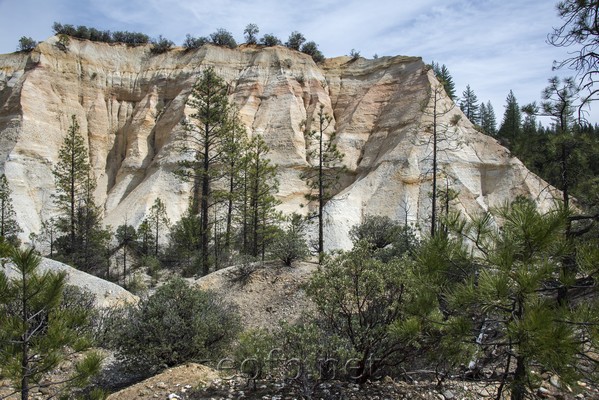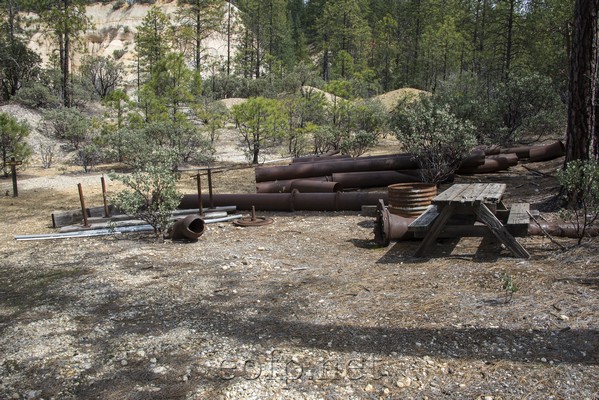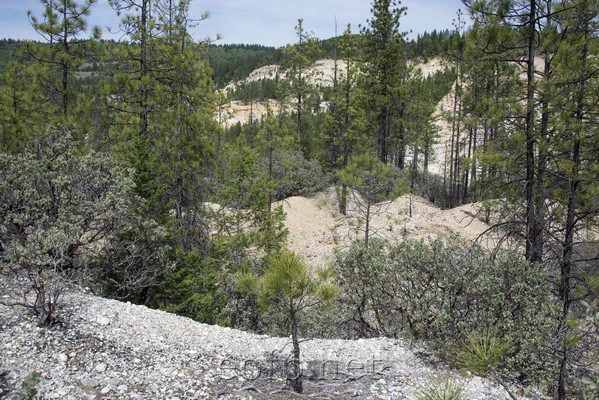Malakoff Diggins State Park, California
6/18/2017

Malakoff Diggins State Park, California
Malakoff Diggins State Park was the site of the largest hydraulic gold mine in California. The mine was active from the 1850s to 1909. It was the source of the silt and sediment that led to the 1884 Sawyer decision which drastically curtailed hydraulic mining in California. Hydraulic mining at Malakoff left a canyon sized pit that remains to this day. Malakoff Diggins State Historic Park contains large tracts of forest, the former town of North Bloomfield, a small museum, and a campground in addition to the hydraulic mine. There is a cash only admission fee payable at the museum which is in North Bloomfield.
Malakoff Diggins State Park, California
Hydraulic mining played a major role in California’s history. Understanding hydraulic mining requires understanding some of the geology of gold in the Sierra Nevada Mountains. The first gold seekers that arrived in California in 1849 panned for gold or dug out riverbanks and shoveled river gravel and sand into sluices to separate the gold from gravel and silt. As early as the 1850s, the best sites on the Sierra Nevada rivers had been thoroughly dug up, claimed and all the easy to find gold had been taken. The Sierra Nevada Mountains are an upraised mass of granite called the Sierra Nevada batholith. This mass of granite fractured in many places as it cooled and rose. Those fractures slowly filled with quartz over millions of years. Gold was brought up from the depths of the earth, carried by steam and gasses, and was slowly deposited within those quartz veins. When quartz veins are exposed by erosion, the concentrated bits and flakes of gold are carried into the fast flowing mountain streams along with eroded granite and quartz. In the streams, the gold is concentrated again as the heavier gold settles out of the water while much of the quartz sand is carried downstream. This is why the 49ers found gold in the river gravel and sand. Once the gold had been taken from the active Sierra Nevada rivers and streams, prospectors started looking for fossil riverbeds and stream beds. Mountain rivers change course and leave their former beds and associated alluvial deposits behind. Miners searched for these “fossil riverbeds” and dug out and sluiced the pebbly and crumbly aggregate stone or soil they had transformed into. The largest fossil riverbed in the Sierra Nevada was left by the ancient Yuba River which was much larger than any current river in California. The ancient Yuba River drained what is now the Great Basin, before the Sierra Nevada uplift cut off its flow. Some of the thickest and richest deposits from the ancient Yuba River were at the Malakoff Diggins site. In places the layer of alluvial deposits is over 600 feet thick. The alluvial deposits left by the ancient Yuba are a sandy aggregate filled with rounded pebbles. It is a soft crumbly material, almost soft enough to carve into with bare hands. The goal of the hydraulic miner was to turn these alluvial deposits into slurry that they could run over sluices which would cause the heavier particles of gold to settle out. They did this by attacking the hillsides with high pressure water. The force of the water pressure was enough to break apart the layers of ancient river bed and turn it into a muddy sandy slurry. The water used was transported in long wooden flumes from artificial reservoirs and diverted streams higher in the mountains. Once the slurry had passed over the sluices at the mine it was discharged into rivers and streams. This discharge created major problems downstream. As rivers and streams exit the mountains into the Central Valley, their currents slow and they drop their load of sediment. Hydraulic mines drastically increased the sediment loads of the Feather, Yuba, American and other Sierra Nevada rivers. The sediment settled in the valley, raised the bottoms of the rivers and caused massive floods. Hydraulic mine sediments destroyed farmland and made navigation to inland ports like Marysville impossible. The sediments were probably partly responsible for the catastrophic 1862 floods.
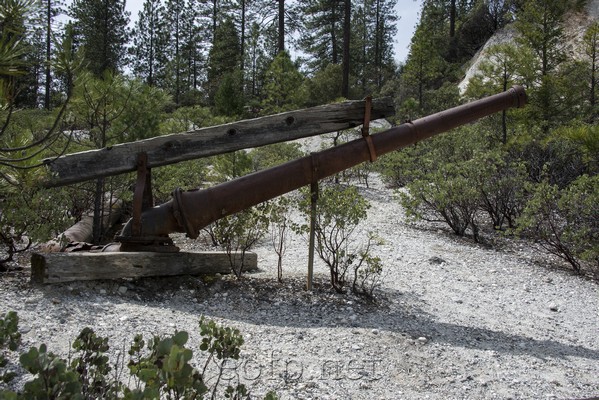
A Monitor Water Cannon at Malakoff Diggins State Park, California
The North Bloomfield Gravel Mining Company was formed in 1866 and purchased over 1,500 acres where Malakoff Diggins Park is today. North Bloomfield, which had been a small mining town, became the center of operations and residence for the new mine. The North Bloomfield Gravel Company built a network of flumes and reservoirs that supplied the mine with 100 million gallons of water per day. Mining commenced in 1876 and began sending millions of tons of silt downstream to Marysville. Residents of Marysville organized the Anti-Debris Commission in 1878 in what was one of the earliest acts of community resistance to industrial pollution. In 1882, a farmer named Edward Woodruff filed a suit seeking an injunction against North Bloomfield Gravel Company. Woodruff’s fields had been covered with silt and debris from the upstream mine and rendered useless. Judge Sawyer’s 1884 decision in the case, the Sawyer Decision, required the impoundment of mine wastes on mine property. This made hydraulic mining impractical and unprofitable. Sawyer’s decision did not apply to all of California and hydraulic mining did continue elsewhere in the state. Sawyer’s decision was an application of nuisance common law and was not the first such application in the country. Sawyer’s decision is sometimes cited as the first environmental law in the country but this isn’t exactly true. It wasn’t a new law but rather the judicial application of existing law. And nuisance common law had been used in other parts of the country previously to address pollution problems. Sawyer’s decision had a major impact on the state of California. It effectively halted the devastating practice of hydraulic mining which had started to fill the San Francisco Bay with silt. It marked a shift in the politics of California from control by miners to an increasingly diverse state with a very prominent agricultural industry. The Sawyer decision was the first time any branch of the local government so decisively sided with agriculture over mining. Mining continued on a drastically reduced scale at Malakoff Diggins until 1910. The area is still scared by the 19th century mining. The main “diggins” pit is still hundreds of feet deep. Vegetation still struggles to recolonize the exposed, sandy and pebbly fossil river bed. Rusty pipes and other hydraulic mining equipment are strewn around the mined area. North Bloomfield has been partially restored and is maintained but has no non-park service residents. Parts of Malakoff Diggins Historic Park were never mined. The forest was all clear cut in the 19th century but has regrown and supports a variety of wild life in the un-mined areas. I saw a black bear on my last visit. Several other hydraulic mines operated near Malakoff Diggins. The remains of one large operation can be seen on Tyler Foote Crossing Road near North Columbia (photo below). There are several historic mining towns nearby including North San Juan, Nevada City and Grass Valley.
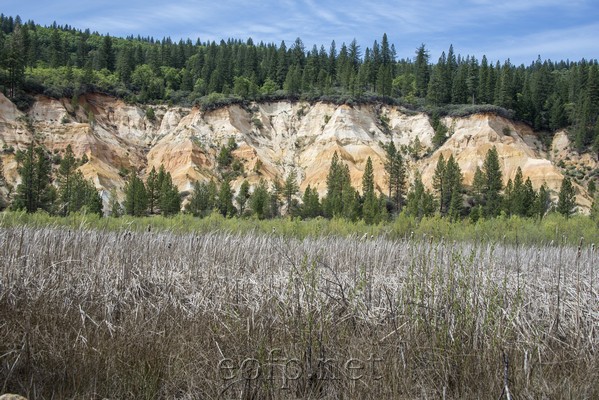
Malakoff Diggins State Park, California
Malakoff Diggins State Historic Park website.

Malakoff Diggins State Park, California
Malakoff Diggins State Park, California
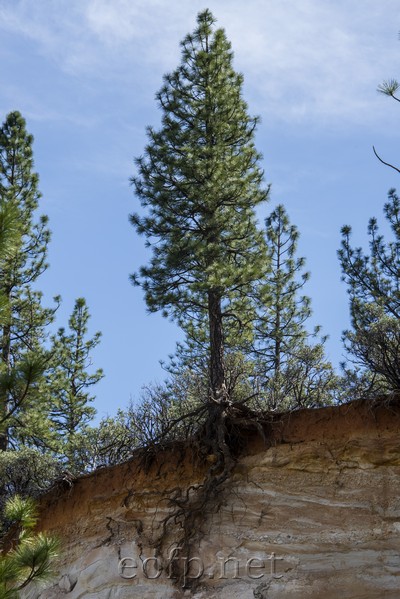
Malakoff Diggins State Park, California
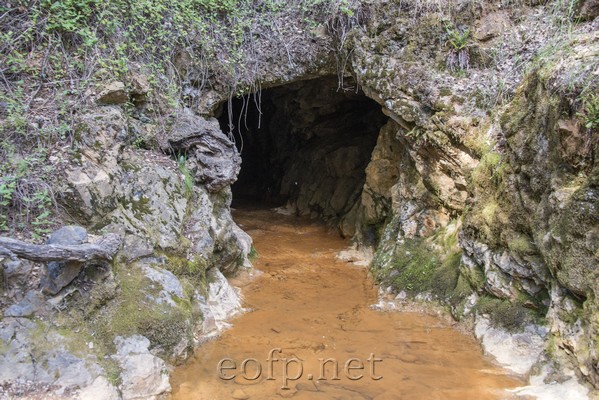
Malakoff Diggins State Park, California
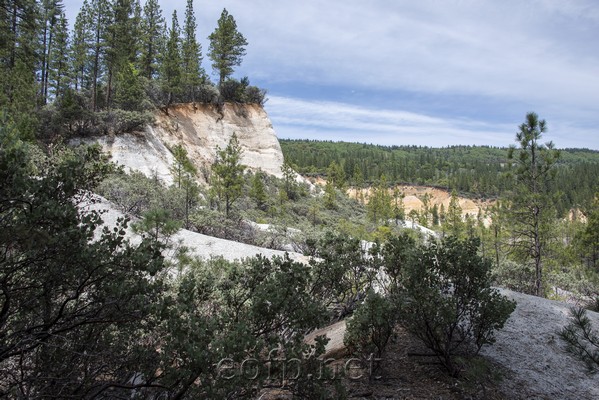
Malakoff Diggins State Park, California

Malakoff Diggins State Park, California
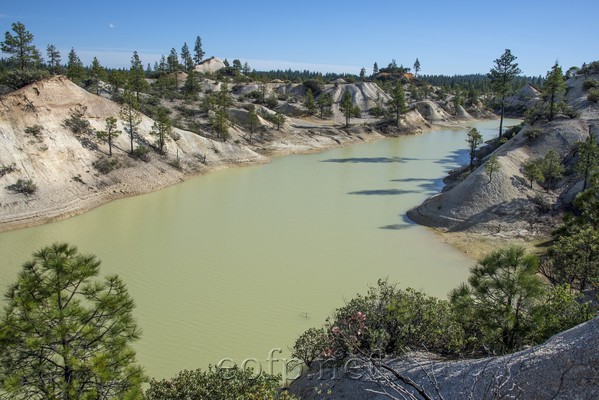
Near North Columbia, California
Malakoff Diggins State Park, California
All content on these pages Copyright Mark Hedlund 2012-2019. All rights reserved. Use in school projects and with links on social media is always okay. Please send me an email to request permission for any other use: hedlunch@yahoo.com Non-exclusive commercial publication rights for most photos is $25 per image.

